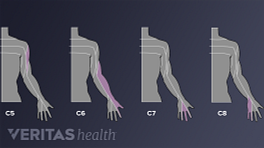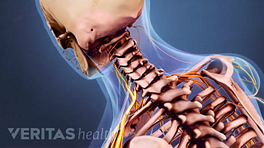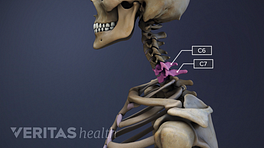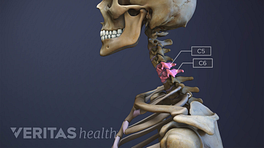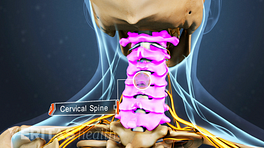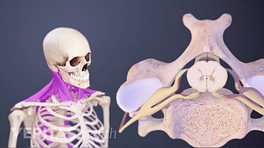There are 8 pairs of spinal nerves in the cervical spine, labeled C1 to C8. Each one is named after the vertebra beneath it, except the C8 nerves, which are above the T1 vertebra. These nerves play important roles in sending messages to and from the spinal cord, enabling the brain to communicate with parts of the upper body.
Each spinal nerve is supplied by 2 nerve roots. The anterior root, located in front, carries motor signals from the brain out to the body. The posterior root, located in back, carries sensory signals from the body back to the brain.
These 2 nerve roots branch directly from the spinal cord and merge to form the spinal nerve as it runs through an opening between adjacent vertebrae, called the intervertebral foramen. From there, the spinal nerve branches into a network of nerves. The body region that receives sensation for a particular spinal nerve is called a dermatome. The group of muscles supplied by that nerve is called a myotome.
There is also significant overlap between adjacent dermatomes and myotomes; and the innervation can vary from person to person. 1 Rainville J et al. Exploration of sensory impairments associated with C6 and C7 radiculopathies. Spine J. 2016; 16(1):49-54.
In general, the cervical spinal nerves have dermatomes that receive skin sensation for the head, neck, shoulder, arm, and hand. The cervical myotomes supply the muscles involved in moving the head, neck, shoulder, elbow, wrist, hand, and fingers.
Spinal conditions including disc herniation or facet joint osteoarthritis may irritate a spinal nerve or nerve root and cause radiating pain, tingling, numbness, or weakness along the path of the nerve. For example, a pinched nerve in the upper cervical spine is more likely to have pain that radiates up toward the head, whereas a pinched nerve in the lower levels may radiate pain down the arm
In This Article:
- 1 Rainville J et al. Exploration of sensory impairments associated with C6 and C7 radiculopathies. Spine J. 2016; 16(1):49-54.

